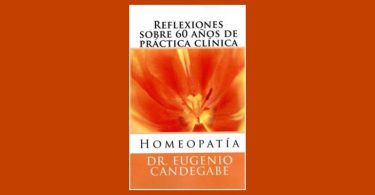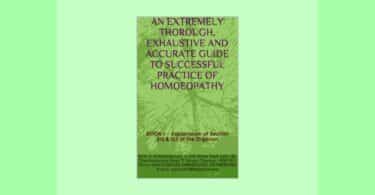Title: Sensation Refined
Author: Rajan Sankaran
Published by: Homeopathic Medical Publishers, Mumbai, India
Year of publication: 2007, hard cover, 432 pages with index
Reviewer: Vatsala Sperling

Ideas and techniques can come fully formed (rarely), or simmer for a while in the cauldron of time (usually) – a cauldron that is stirred by various users to see if the idea is ready for sunshine. The sensation idea followed the second and more natural course from the get go.
As Dr. Rajan Sankaran presented the idea of the sensation method in the late 1980s, began teaching this method, sharing cases and writing books about it, he witnessed his idea simmering in the cauldron. Various users who stirred it turned out to be seasoned homeopaths from all over the world who began applying the method in their own practice, communicated with him and with each other, about their successes, failures and glitches that they encountered.
At this point, Dr. Sankaran took over the task of refining, perfecting, fine tuning the technique and expanding the knowledge base till a time came when he could say, ‘The sensation idea has come of age’ and then he summarized his experience in this book, “Sensation refined”.
To be able to make anything out of this book, of course, you must build your base gradually, starting from book one by the author, ‘The Spirit of Homeopathy’ and make your way methodically from book 1 through book 8 and then you can pick up and enjoy the book number 9, “Sensation Refined.”
In one word, I will call this book, “Crisp.” Reading it today, 14 years after it was first published in 2007, I am ready to choose a cheeky title for this book and rename it as “The Sensation Method in Aphorisms.” When I extract the points that have been clarified, refined and elaborated, the list will indeed read like aphorisms that explain the sensation method and its successful application in day to day practice. Here you go:
- Experience the truth
- Gesture is the key
- The sensation is an experience
- Go with the flow to the deepest level till you arrive at the sensation. Just listen and stay with the experience. The language within is not the language of the human being.
- There are differences between kingdoms, nosodes and imponderables. This difference is to be seen at the sensation level and not at the level of facts, feelings and delusions.
- Miasm is the way sensation is experienced.
- Be aware of prejudice.
- See what does not fit.
- Ask again and again till you get a bit deeper.
- Observe phenomena during case taking at the sensation and energy levels. At these levels, whatever happens and any co-incidences are all significant.
- On seeing energy in hand gesture and hearing non-human specific words, take off on a tangent, and reach the inner world more easily.
- The sensation level can be divided into three sublevels: Kingdom with words specific for kingdom, subkingdom with words for family, class and row, and source with words specific to source.
- The sensation sub-level C is further divided into C1- Approximations (not exact, but effective enough). C2- Characteristics from repertories and provings and C3- Specific and exact qualities of the source, these will be most non-human specific symptoms of the patients.
- Most peculiar symptoms belong to the source.
- The sensation has seven essential qualities, the seven ‘I’s: inherent, innate, intrinsic, ingrained, integral, individual and inevitable.
- The sensation in a case can be found by sticking to the seven ‘R’s: rooted, represented, repeated, replicated, related, retained, refined.
- The sensation has seven features, ‘the seven ‘P’s: Persistent, primary, permanent, pattern, pervading, perpetual, projecting.
- Everything about the patient is an expression of his sensation.
- A person connects at the deepest level to all phenomena associated with the source of the remedy he requires.
- The sensation is the global in the local. The core sensation is a thread running through every sphere of the individual’s life and activities. When a local sensation goes beyond time and space, it is global.
- The sensation lies at the meeting point of two discreet aspects.
- In children’s cases, global extends to include mother’s pregnancy history.
- Several doors open up to global – hand gestures, sensation, modalities, concomitants. The effects of the local issue (physical symptoms, pathology, emotions, delusions) on the person point to what is global in him – his vital sensation.
- Global themes of mineral kingdom are lacking / losing, development and ability.
- Global themes of animal kingdom are pattern, sequence, struggle, competition and survival.
- Global themes of plant kingdom are sensitivity, changeability, adaptability and reactivity.
- MNOPQRS – The words that help us go deeper into the patient’s experience: M – movement, N- non-human specific, O- obdurate, P- picturized, Q- queer, R-repeated, S-synonym or antonym of a previously mentioned word
- Specific, repetitive and energetic hand gestures help us understand the deepest sensations
- The sensation will almost always be accompanied by hand gesture and miasm will almost never be accompanied by hand gesture.
- Doodles are spontaneous and natural every-day expression of the sensation and are a doorway to an unconscious association.
- Patients in acute situations also bring up sensation words. Change the remedy when symptoms change. Always treat what is in front of you.
- The seven levels are – name, facts, emotions, delusions, sensation, energy and blankness or beyond energy. Potency is selected according to the level that is experienced daily by the patient.
- Level 1, Name – 6c – LM 1 and 2,
- Level 2, Facts – 30c, LM 3 and 4
- Level 3, Emotions – 200c, LM 5 and 6
- Level 4, Delusions – 1M, LM 7 and 8
- Level 5, Sensation – 10M, LM 9 and 10
- Level 6 Energy – 50M, LM 11 and 12
- Level 7, Beyond energy – CM
It is reasonable to stop here with the extractions so that you can discover the rest of the book on your own. All these aphorisms are accompanied by interesting anecdotes, super-micro or ultra-mini cases that exactly illustrate the nuggets of ‘sensation truth’ contained in the aphorisms.
Reading this book gives me an impression that I will be reaching out to it just as I reach out to the Organon – meaning anytime I get stumbled in my study and practice, and since the stumbling happens quite often, I will keep this book nearby and discover practical hints, tips and wisdom contained within its pages.






Very nicely presentated Dr Vatsala.
Great job.
Thank you!
Several years back I did Book review of Sensation Refined that got published in The American Homeopath
https://kavithakhomeo.com/wp-content/uploads/2019/09/Book-Review-Sensation-refined.pdf